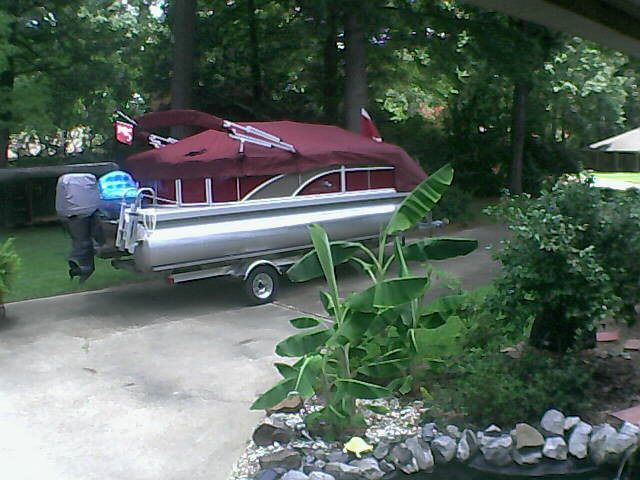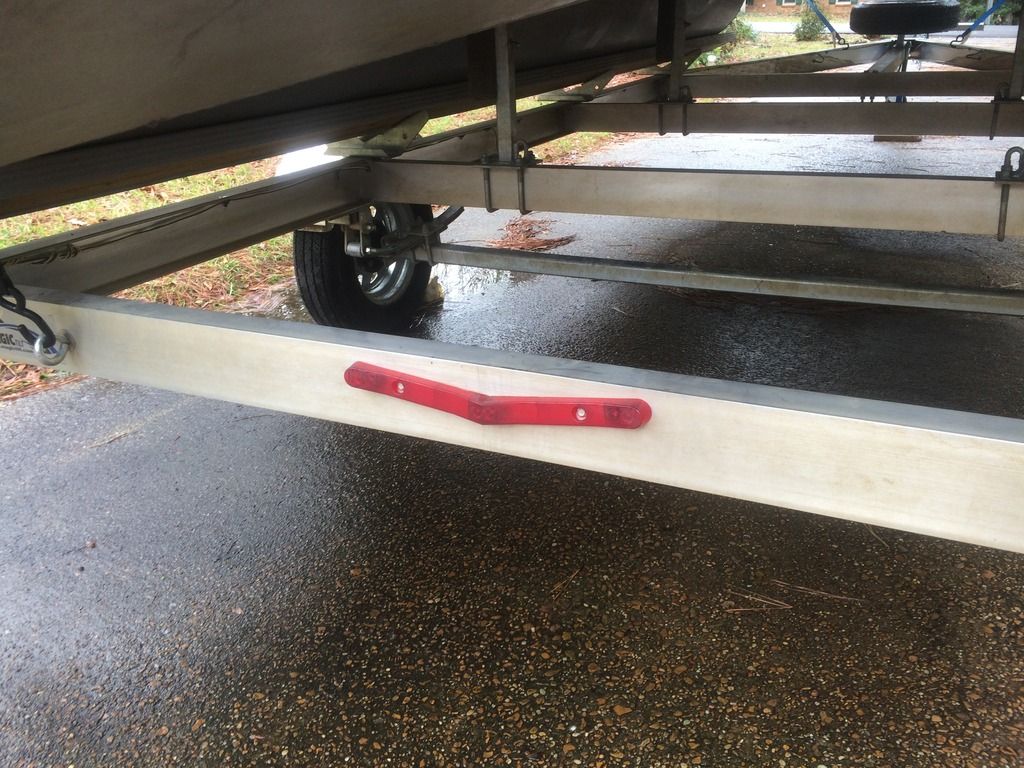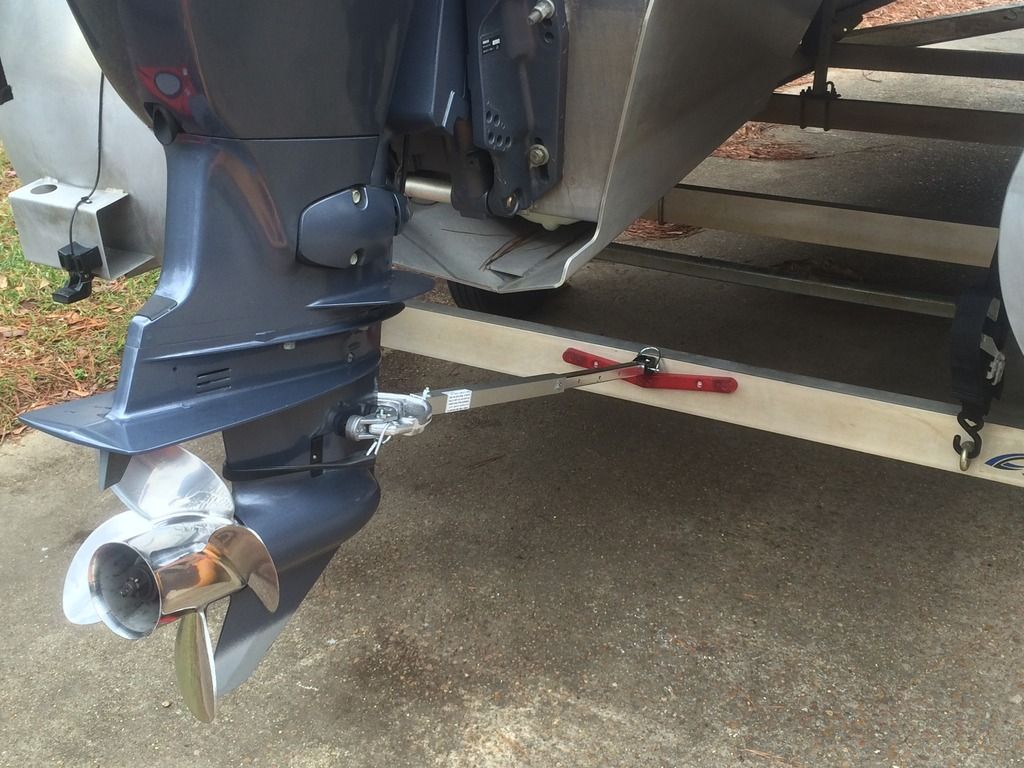Navigation
Install the app
How to install the app on iOS
Follow along with the video below to see how to install our site as a web app on your home screen.
Note: This feature may not be available in some browsers.
More options
You are using an out of date browser. It may not display this or other websites correctly.
You should upgrade or use an alternative browser.
You should upgrade or use an alternative browser.
Transom Saver
- Thread starter Spoiledrotten
- Start date
cwag911
Moderator
Nice job!
Link
Moderator
Spoilledrotten, not educated about this; Why? For long hauls?
MH663
Well-Known Member
Takes the load/weight of the motor off the transom and the hydraulic cylinders used for trim which are obviously not shock absorbers. Just think about all of the bouncing around the motor does while being towed. Even if you strap the motor down the lateral load of the weight of the motor on the transom is not good bump after bump after bump. Sorry, I don't know the technical way to explain it. It is recommended by Bennington as well.Spoilledrotten, not educated about this; Why? For long hauls?
Be sure to double check the clearance of the skeg to the road. In this picture it looks close but that could very well be the angle of the pic.
Looking for others to comment as well.
Last edited by a moderator:
Spoiledrotten
Well-Known Member
MH663, Nice explanation. Couldn't have done it better myself. That sums it up Link. It's great insurance against cracks in the transom, due to the banging up and down on the long hauls, and that even means more than a mile or two. I won't be using it just running a half block around to the boat ramp in our neighborhood, but to run up a couple of miles to fill it up or towing it on vacation, I feel that it's good to have.
As far as the distance from the bottom of the motor to the concrete, that pic is a bit deceiving. I've actually got over a foot on clearance.
Here's a pic of the boat from a little ways away, and I've even got the boat tilted upward in the front on this one.

EDIT: I went out and measured the distance after getting home. The distance between the concrete and the motor, is 21". When I hook up, it raises the motor about 3 more inches. I think I'm safe.
As far as the distance from the bottom of the motor to the concrete, that pic is a bit deceiving. I've actually got over a foot on clearance.
Here's a pic of the boat from a little ways away, and I've even got the boat tilted upward in the front on this one.

EDIT: I went out and measured the distance after getting home. The distance between the concrete and the motor, is 21". When I hook up, it raises the motor about 3 more inches. I think I'm safe.
Last edited by a moderator:
highpond
Well-Known Member
From a lesson learned. The Benny is a lot heavier boat than most pontoons. I kept a trailer from a previous boat because it was only two years old. Towing the New Benny the next year on the interstate we had a blow out. The trailer was single axel. I did have a spare but no way to get the trailer jacked. Got road service.
The result was that I went to my dealer and ordered a two axle setup with breaks. Single is too light for long distance and 10" wheels, Forget it. Watch your springs. They look great now with a good bow in them. In a year or two the springs will flatten
Take a hint, look into a 2 axel trailer. By the way if a tire goes flat you can still drive it, all be it very slow.
The bar? I heard that if the road is very rough the lower unit can crack.
Luck with the NEW BOAT
The result was that I went to my dealer and ordered a two axle setup with breaks. Single is too light for long distance and 10" wheels, Forget it. Watch your springs. They look great now with a good bow in them. In a year or two the springs will flatten
Take a hint, look into a 2 axel trailer. By the way if a tire goes flat you can still drive it, all be it very slow.
The bar? I heard that if the road is very rough the lower unit can crack.
Luck with the NEW BOAT
kaydano
Well-Known Member
- Messages
- 4,287
- Reaction score
- 2,163
I thought Bennington did not recommend transom savers...
+1 on dual axles and brakes.
+1 on dual axles and brakes.
MH663
Well-Known Member
I emailed Bennington direct and they replied; We do recommend using a transom saver.I thought Bennington did not recommend transom savers...
+1 on dual axles and brakes.
Dual axels and dual brakes for me.
highpond
Well-Known Member
When I'm traveling I set the motor all the way down. True the pressure is off the motor lifts as its up against the transom, but the transom should be strong enough to handle the rough roads with the motor on it. To take some of the shock I use tie downs from the loop on the toons to the trailer. The trailer with good springs and duel tires will lesson the bumps, the boat can't move off the toon ramps if tied down tight.
MH663
Well-Known Member
Confucius say;
"If you want to hear it straight from the horse, you should probably ask the horse the question"...lol.
It's all good.
"If you want to hear it straight from the horse, you should probably ask the horse the question"...lol.
It's all good.
kaydano
Well-Known Member
- Messages
- 4,287
- Reaction score
- 2,163
Here's an old post about asking the horse...
RolandAdmiral
Posted 06 September 2012 - 04:01 AM
Hi guys... well between this forum and one other I frequent, I pretty much got a mixed bag of answers with regard we should use a transom saver when towing our bennys... so I decided to go right to the horses mouth.. sent an email to Bennington and asked them what the companys stance on this was.... got the reply today, they DO recommend the use of transom savers.... I started out to just get an old fashion TS that connects the trailers cross member to the lower unit... but then started reading all this stuff about " trailer shock " where hitting bumps, potholes, actually may damage the gears in the lower unit.. then I looked into the "wedge" devices, like " m-ywedge.com ". But I think the best one I've seen on the market is called motor mate. It has a bracket that actually bolts to the bottom of the lower unit... then the motor mate clips into that with two extension arms that attach to the lower unit. From what I've seen it not only supports the motor, but it also holds rock solid so that it can't tilt from side to side.... only problem is so far on their web site, the smallest yamaha motor there product will fit in a 4 stroke is a 115... I've got a 75. for those of you interested you can check it out at motormate.com At the top of the screen is a tab for youtube videos... It's a bit expensive, I think around $110 or so... If they don't make one that fits a 75, think I'll go with the wedge that fits over the cylinder rod that raises the motor... Weekends almost here, supposed to be in the low to mid 80's this weekend... screw the lawn, I'm going fishing!!!! before I go, in some or your responses, you said you lowered your motors till the "tabs" caught. Can you explain to me what those are.. I've always just trimmed my motor until it was all the way down when towing.
Roland
RolandAdmiral
- LocationShreveport, Louisiana
Posted 06 September 2012 - 04:01 AM
Hi guys... well between this forum and one other I frequent, I pretty much got a mixed bag of answers with regard we should use a transom saver when towing our bennys... so I decided to go right to the horses mouth.. sent an email to Bennington and asked them what the companys stance on this was.... got the reply today, they DO recommend the use of transom savers.... I started out to just get an old fashion TS that connects the trailers cross member to the lower unit... but then started reading all this stuff about " trailer shock " where hitting bumps, potholes, actually may damage the gears in the lower unit.. then I looked into the "wedge" devices, like " m-ywedge.com ". But I think the best one I've seen on the market is called motor mate. It has a bracket that actually bolts to the bottom of the lower unit... then the motor mate clips into that with two extension arms that attach to the lower unit. From what I've seen it not only supports the motor, but it also holds rock solid so that it can't tilt from side to side.... only problem is so far on their web site, the smallest yamaha motor there product will fit in a 4 stroke is a 115... I've got a 75. for those of you interested you can check it out at motormate.com At the top of the screen is a tab for youtube videos... It's a bit expensive, I think around $110 or so... If they don't make one that fits a 75, think I'll go with the wedge that fits over the cylinder rod that raises the motor... Weekends almost here, supposed to be in the low to mid 80's this weekend... screw the lawn, I'm going fishing!!!! before I go, in some or your responses, you said you lowered your motors till the "tabs" caught. Can you explain to me what those are.. I've always just trimmed my motor until it was all the way down when towing.
Roland
lakeliving
Well-Known Member
Maybe they changed the transom's since 2012.
TomS
Well-Known Member
gnc1017
Well-Known Member
My dealer recommended trailering it with the motor at the top trim position - resting just on top of the trim cylinders to take the stress off the top 'trailering' cylinder. This is on a Yamaha so maybe Merc's are different? He primarily recommended that to make sure the skeg wouldn't touch the pavement if going through any dips like at the entrance/exit of a parking lot. You'd be surprised how many times you could encounter that. He's actually got a dip coming off the highway at his shop and the asphalt is full of skeg marks from his customers. Ouch!
He also didn't like the gearcase shock of the 'transom savers' but I agree that if the back of the boat is strapped down tight, wouldn't think it to be a problem. Wouldn't consider it without good strapping though.
Since Yamaha has the My-wedge accessory, figured it must be beneficial and since Bennington guarantees their transom, we went that route. Just remember on some Yamaha motors (maybe all?) You have to put it on the port side or it can break off the nearby grease fitting. It would be obvious once you look at it the first time which side could be a problem.
He also didn't like the gearcase shock of the 'transom savers' but I agree that if the back of the boat is strapped down tight, wouldn't think it to be a problem. Wouldn't consider it without good strapping though.
Since Yamaha has the My-wedge accessory, figured it must be beneficial and since Bennington guarantees their transom, we went that route. Just remember on some Yamaha motors (maybe all?) You have to put it on the port side or it can break off the nearby grease fitting. It would be obvious once you look at it the first time which side could be a problem.
Havasu
Well-Known Member
I use the Yamaha wedge type on mine. The 350 takes two of them. I went that route because on my old SW boat (Parker PH) with twin Yami 150's, I used them and towed a lot. Most of the time I was towing 50+ miles one way to launch. In 4 years, I never had an issue and they act like a shock absorber on the heavier bumps.
Spoiledrotten
Well-Known Member
Good replies on the topic. Keep them coming. I don't plan on trailering mine over one trip per summer. The rest of the time will be going about a half a block to our neighborhood's private boat ramp. This is a 20' boat with the 90 horse, so I'm going to trust that Bennington matched the right trailer with the boat. if there are problems, I might have to take it up with the company. Hopefully, there won't be anything to that. I am planning on adding a little larger tires/rims to the current trailer.
Last edited by a moderator:
Link
Moderator
Spoiledrotten, I believe that it is the dealer that matches the trailer to the boat, not Bennington. If you have concerns you might want to touch base with your dealer
Last edited by a moderator:
MH663
Well-Known Member
True That!Spoiledrotten, I believe that it is the dealer that matches the trailer to the boat, not Bennington. If you have concerns you might want to touch base with your dealer
highpond
Well-Known Member
The dealer is willing you sell you what he has in stock. Bennington makes boats Trailers come for someone else and it may not be strong enough for a Benny. The tires should have a D Rating and if your doing any highway driving, duel wheels with a rim larger than 10" is the only way to go with a break system.
Check weight capacity marked on the trailer. Don't be fooled by Benny published weight you'll find it's a lot more after loading it up for a day on the water.
Check weight capacity marked on the trailer. Don't be fooled by Benny published weight you'll find it's a lot more after loading it up for a day on the water.
kaydano
Well-Known Member
- Messages
- 4,287
- Reaction score
- 2,163
I weighed my boat/trailer on a CAT semi scale at a Casey's a couple years ago. I think it came in at 5100 lbs. That includes the dual axle trailer. If I recall correctly, most states require brakes at 3000 lbs.
You can look up the empty weight of your boat on the Bennington website, but don't forget to add the motor (~500 lbs), gas (200-400 lbs depending on tank size), gear (200-400 lbs, includes anchors, batteries, coolers, and all the little stuff adds up).
If I remember right, my boat weighted around 2000 lbs on the website. Maybe less. But add another ~1500 for motor, gas and gear and 1500+ for trailer and you can hit 5000 lbs pretty quick for an S model.
I think people underestimate the motor/gas/gear weight. And, the G/R/Q models are heavier than an S.
You can look up the empty weight of your boat on the Bennington website, but don't forget to add the motor (~500 lbs), gas (200-400 lbs depending on tank size), gear (200-400 lbs, includes anchors, batteries, coolers, and all the little stuff adds up).
If I remember right, my boat weighted around 2000 lbs on the website. Maybe less. But add another ~1500 for motor, gas and gear and 1500+ for trailer and you can hit 5000 lbs pretty quick for an S model.
I think people underestimate the motor/gas/gear weight. And, the G/R/Q models are heavier than an S.




